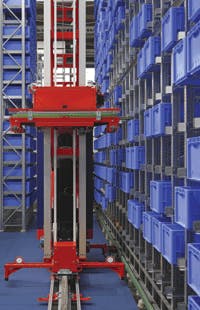Electric drives account for a high proportion of energy consumption in the average warehouse or plant infrastructure. From product conveying and sortation, to pick-and-place robotics for order fulfillment, to packaging and labeling for shipment, virtually every automated function relies on electric drives and represents potential for cost savings.
High material handling throughput, packing density and high energy efficiency can help contain costs in automated warehouses. Saving energy can be one of the toughest challenges in power system design for machines and processes. Multiple parameters determine the energy efficiency of required drive systems. Savings can be derived from any number of approaches, some more productive than others. In selecting an automated system, the goal is to choose efficiency and availability, not added cost and crisis scenarios. By taking an analytical approach to mechanical processes and energy requirements, you can simplify the process and help determine the most beneficial measures.
Uniform drive systems can help save energy over time and can also optimize processes, lowering life-cycle costs. Motor drive sizing and technologies now provide expanded support for material handling tasks, with fully integrated energy efficient packages comprised of engineering design software, 120hz gear motors with beveled gearboxes and variable frequency inverter drives.
A series of steps can help ensure the right design and "right sized" motor drive and control components for an energy efficient drive system.
Analyze and Compare Drives
A complete drive system should take into account motion, mechanical components and drive components. The total energy efficiency can be calculated, e.g., for a complete production line, and the energy part of the production costs and, additionally, CO2 emissions can be determined. Additionally, it is possible to determine potential savings by using DC power recovery instead of a brake resistor.
Precise dimensioning of material handling drive components can achieve the highest level of efficiency and, thereby, lowest energy input for a given task. Over-dimensioning should be avoided. By the same token you don’t want components subjected to extreme overloads. In general, the longer the drive operating time, the higher the cost savings.
Achieving efficiency goals starts with the design process and use of the design software for precision drive dimensioning by tailoring the system specifically to the material handling application requirements. This can prevent the common problem of over-dimensioning motors and inverter control and regulation of the drive systems. There is design software available for recording and saving scenarios showing the projected energy consumption of proposed designs.
Software can also provide an energy performance certificate showing energy consumption of an application and individual drive components, with recommendations for optimizing drive efficiency. Seeing the options provides a side-by-side comparison of different solutions, including mechanical concepts and drive components with respect to energy demands and optimization.
Energy Efficient Drives
The right energy efficient package can offer design freedom and ensure a right-sized motor that provides equal or greater output to replace larger, more costly and less energy efficient motors.
Classic three-phase AC motors typically increase in size as energy efficiency improves. This can lead to space issues inside a machine and other negative effects, since greater inertia actually increases energy consumption when changing speeds. The ideal operating condition for the most commonly used 4-pole three phase AC motor is roughly 120Hz to achieve high power output, a wide speed range and a high degree of efficiency.
Multiple frequency motors provide a wide speed range and a high degree of efficiency, while concurrently reducing cost and energy usage. High performance 120Hz multi-frequency three-phase AC motors were developed based on these goals. The electrical winding design is geared to a rated frequency of 120Hz with a supply voltage of around 400V or roughly 3,500 RPM to increase both dynamic performance and productivity. 120Hz multi-frequency three-phase AC geared motors with a 96 percent efficient bevel gearbox are inverter optimized for variable motion in power ranges of 0.55 to 22kW. Two-stage bevel gearboxes are characterized by high efficiency, lightweight aluminum housing and wear-free gear teeth.
For variable speed applications, compact 120Hz multi-frequency AC motors provide added value, including space savings. Designed for tasks requiring variable setting ranges with minimal sizes, 120Hz multi-frequency geared motors exceed efficiency class IE2 and deliver speed ranges of 24:1. In comparison, conventional motors offer an adjustment range of only 3:1. Since the speed setting range is double that of conventional motors, 120Hz multi-frequency motors allow applications that require both slow and fast speeds to be implemented using a single motor, with constant torque throughout the entire setting range.
Ultimately, the material handling end user wants reliability, more picks, availability, and stock security. High throughput, high packing density and high energy efficiency minimize costs and increase flexibility in automated warehouse systems. A single motor version can serve varied application for standardized processes. These compact three-phase motors enable energy-efficient drive solutions without costly design alterations. Inverter-optimized asynchronous 120Hz multi-frequency motors can be up to two frame sizes smaller than conventional IE2 motors, while offering the same performance output. The inertia is lower than standard AC motors, which results in high dynamic response time from 0-3500 rpm in 500 milliseconds.
New high-speed performance storage and retrieval units on the market can accelerate to high traveling speeds very quickly within warehouse bays. Energy efficient drive and control technology ensures the necessary dynamic response capability. Use of composites rather than steel construction can significantly lighten the load, thereby reducing the mass that needs to be driven and, as such, enables the use of smaller drive axes. Reduced load for lower mass inertia in conjunction with synchronous servo motors can make enormous acceleration rates possible in next-generation storage and retrieval units.
Efficiently Convert Energy
Excess, unused energy is the most costly energy. Proper utilization of braking energy can yield improved energy efficiency. Many applications with electric drives require frequent acceleration and braking. When accelerating or lifting, electric energy is converted into kinetic energy, some of which is recovered when braking or lowering. Recovered energy is often converted into unused heat via a brake resistor. In some applications it is worth capturing braking energy to exchange between drive systems or for short-term storage in a capacitor module or power recovery to the mains. Regenerative power tends to be most useful and cost-effective at outputs greater than 5 kW, but energy savings are typically nominal.
Mechanical power output by the electric drive must be oriented toward the automated task to make the most effective use of energy in all drive processes. More than a third of newly installed three-phase AC motors are optimized for frequency inverter operation and operated using electronic control systems. The advantages of 120Hz multi-frequency three-phase AC motors become even more apparent in drive packages with gearboxes and frequency inverters. By combining a decentralized inverter drive with a high efficiency geared MF three-phase AC motor, the connection is straightforward, energy efficient, and eliminates the requirement for a control cabinet.
Calculate Energy Savings
Industry-wide class IE2 efficiency standards have propelled many developments in inverter design that are driving industry to higher levels of efficiency, without sacrificing performance. The decentralized inverter, for example, features voltage frequency control, an intelligent energy saving function that adapts the motor magnetizing current to actual process needs and, consequently, reduces losses, particularly in partial load operation. This in turn improves efficiency and reduces energy consumption by up to 30 percent.
With the consensus that the IE3 efficiency standards will be met by the permanent magnet synchronous motors, most of the decentralized series of drives has the ability to run these motors without any feedback. This feature also allows open loop control on some positioning applications. The cost of feedback can be eliminated in these applications and is a considerable value for the system.
Putting all of this into perspective, let’s consider a large food distribution center using upward of 10,000 geared motors and drives. In an operation of this magnitude it is easy to understand why right sizing is so important by doing a cursory cost calculation on the motors alone. Assume all the motors operate with an IE2 efficiency of 84 percent, and a fully loaded 2kW motor delivers 2,000 watts of mechanical power to the load. The electrical power required is the mechanical power divided by the efficiency.
Calculated power usage would be 2,000/.84 = 2,381 watts. In a 24-hour window, the energy consumption is 57 kilowatt hours. Assuming a $0.10 per kW/hour cost, a 24 hour period would cost $5.70 per motor. By right sizing and deploying a mechatronic solution providing even a modest one percent improvement in efficiency, a large distribution center with 10,000 geared motors and drives can yield savings upward of $570 daily. Extrapolating over the course of a year the energy savings quickly accrue.
Don’t Overlook the Easiest Solutions
The best innovations are those that recognize the potential for making life easier and lead to real added value for the end user—those on the frontline in the warehouse. Roller, chain and belt conveyors are the classic types of conveyors in horizontal material handling systems and make use of relatively simple drive solutions.
In machines, especially modular machines that involve frequent motion, there are different ways to solve the drive automation task in question. For machines that execute multi-axes, concatenated movement (e.g., robots), a controlled-based topology with central motion control is a foregone conclusion, whereas in conveyor and winding applications, a drive-based topology may be advantageous.
Determining the optimal drive solutions means understanding the material handling processes and relevant drive technologies to get the job done most efficiently.
Tom Jensen is program manager, OEM Business Development, for Lenze Americas, www.lenze.com.






